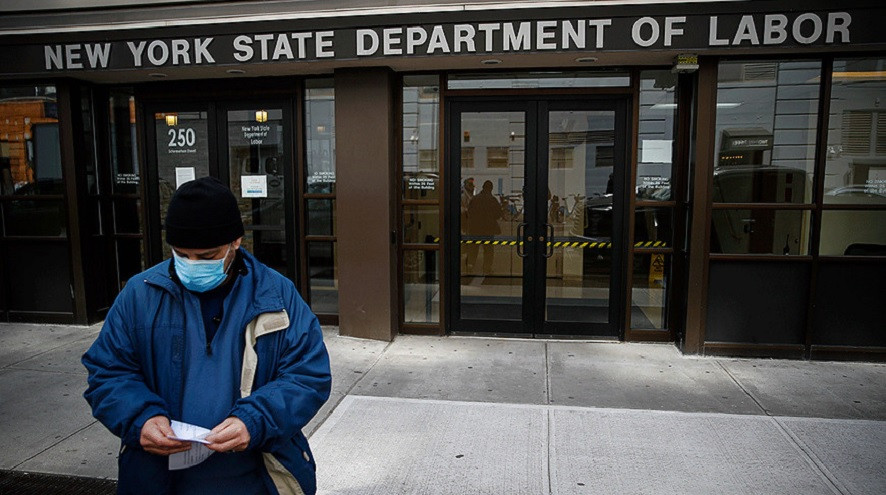Job growth in the US has barely shown an increase this year, while the unemployment rate has fallen more than forecast - to 4.2%, showing a controversial overall result that could still push the Federal Reserve to accelerate the curtailment of pandemic incentives.
Weak employment data divided experts into two camps
The US Department of Labor on Friday reported that in November the number of jobs, excluding the agricultural sector, increased by 210 thousand after an upward revision in each of the previous two months. This is a very low indicator in comparison with the projected +550 thousand jobs and a decrease in unemployment by 4.5%. The labor force participation rate rose to 61.8%.
The average hourly wage in November increased by 4.8% compared to last year, but these figures are not adjusted for inflation. There is practically no real increase. The average length of the working week increased slightly - to 34.8 hours in November from 34.7 hours a month earlier.
The number of jobs was reduced, including in retail and education. Employment growth was also held back by the leisure and hospitality sector, which added only 23,000 jobs after an increase of 170,000 in the previous month.
The number of jobs in the field of professional and business services increased by 90,000 people. Transportation and warehousing services added about 50,000 jobs, while the number of jobs in the construction sector increased by 31,000. Employment in the manufacturing industry increased by 31,000 people.
The study shows that employees find a job fairly quickly. From May of last year to November of this year inclusive, more than 5 million people have already been employed.
Service Sector - Controversial-favorable report
The indicator of activity in the US service sector rose in November, reaching a new record level, as companies increased recruitment. This growth stunned economists, predicting a drop to 65 points. Last month, the indicator of new orders received by service enterprises amounted to a record 69.7. Alas, there were almost no signs that supply constraints were easing, although prices remained high.
The Institute for Supply Management said Friday that its non-manufacturing activity index rose to 69.1 last month, the highest reading since the series began in 1997, from 66.7 in October. A reading above 50 indicates growth in the services sector, which accounts for more than two-thirds of U.S. economic activity.
With the growth of employment in the service sector last month, it was possible to reduce the amount of work in progress.
The reason for the sudden increase was the delay in deliveries. The indicator of supplier deliveries did not change and amounted to 75.6 (a value above 50% indicates slower deliveries). Usually, the growth of the index is based on the strengthening of economic indicators and increased consumer demand, which would be a positive contribution to the non-manufacturing ISM index.
Price markers for services remain high, dropping only 0.6 points compared to last month.
Unsatisfactory figures
The decrease in the overall unemployment rate by four-tenths of a percent since October occurred even after almost 600 thousand people joined the labor force.
The unemployment rate among black Americans is also showing lows since the beginning of the pandemic, but this is most likely due to a decline in economic activity, as the participation rate also fell by 0.3% - to the lowest level since July.
For women aged 25 to 54, the participation rate has risen to a pandemic peak. This may mean that the problems with child care are decreasing. Nevertheless, it remains 1.3% below the pre-pandemic highs.
The vacancy report consists of two parts - data from employers and households (including the category of self-employed). The survey of the first showed that recruitment slowed down in all industries, including automakers and trade. A survey of households showed that employment increased by 1.14 million people, and many remained out of the game.
The number of open jobs may continue to decline if the recent appearance of omicron, a variant of the coronavirus, leads to new restrictions and deters people from looking for work. The number of jobs is still 3.9 million fewer than before the pandemic.
Experts believe that recruitment is hampered by a shortage of workers. November was the second full month of hiring after the expiration of the federal-state unemployment benefit in early September. At the end of September, 10.4 million vacancies were opened. Sectors requiring low-skilled labor, which often attract migrants and the black population of the United States, have been particularly affected.
Economists also note secondary factors among possible reasons: a strong stock market and high housing prices have increased the well-being of many Americans, contributing to early retirement. Households have also accumulated huge savings, so there is a surge in self-employment.
The reaction of the Fed and the markets
The main Wall Street indices opened higher on Friday, as investors decided that the Federal Reserve would postpone the tightening of monetary levers.
"The numbers (jobs) are very disappointing, and the market is growing, because now the market expects that the Fed will not be able to act so quickly," analyst Thomas Hayes comments on the events.
But some economists have already expressed the opinion that such a decrease in the unemployment rate and an increase in labor force participation may push the Federal Reserve System to tighten policy faster than planned since inflation is more stable than previously thought.
Earlier this week, Fed Chairman Jerome Powell said the US central bank would consider at its upcoming meeting the possibility of winding down its bond-buying program more quickly, a move that many see as opening the door to an earlier interest rate hike.
Recall that the central bank's dual goal requires it to weigh both price stability and maximum employment, and some policymakers fear that ending monetary support too quickly could hurt job recovery.
"We have to balance these two goals when they conflict, as they are now," Fed Chairman Jerome Powell told the House Committee on Financial Services on Wednesday. "I assure you that we will use our tools to make sure that this high inflation that we are experiencing will not take hold."
Powell's speech caused stock markets to fluctuate between gains and losses all week. Investors, among others, digested updated information about the recently discovered variant of the Omicron coronavirus, which is spreading around the world and forcing many countries to re-impose travel restrictions.
"We had a very unstable week, and I see that this constantly changing environment remained somewhat balanced, as we receive more news on both sides of the impact of the Fed's policy decisions, as well as more information about the Omicron option," analyst Brian Wendig notes.
In other words, it is difficult for the market to digest such multidirectional signals.
After the report, several economists are still confident that the Fed will accelerate the pace of tapering at the meeting at the end of December since inflation leaves the regulator no choice.
"While this still indicates that the economy has about 10 months left to close the full employment gap, the unemployment rate is approaching at a relatively rapid pace compared to the Federal Reserve's estimate of full unemployment," said Brian Bethune, a professor at Boston College.
The resulting impact of all factors is impossible to predict yet. In addition, more will be known about the new strain by the end of the month. At one time, the delta variant strongly bent the indicators of the third quarter. Perhaps history will repeat itself. Will this force the Fed to abandon its plans to reduce stimulus? Unlikely. Inflation has accelerated, and we are not talking about raising interest rates yet - only about limiting the volume of bond repurchases. So most likely the hawks are right, and the tightening will take place.
























